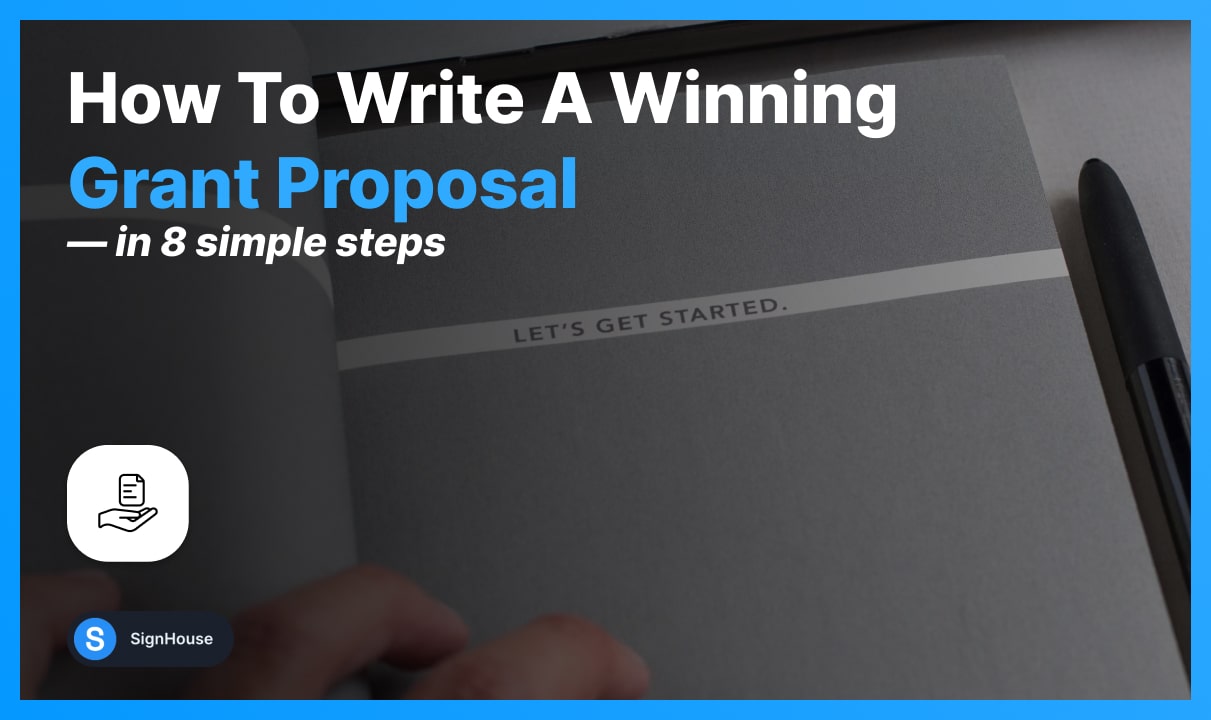How To Write A Perfect Grant Proposal (2024)

Definition: A grant proposal, also known as “grant writing”, are documents requesting funding from an institution (e.g. governments, organizations etc).
In most cases, grant proposals represent a project’s idea and explain why there’s money needed to fund the project in order to motivate the investor.
Obviously, these docs have to be written in a formal way so as to obtain the funding.
In this post, we’ll show you how to write the perfect grant proposal.
Can anyone write a grant proposal?
Yes, anybody can write a grant proposal. Though, not everybody can make a good one, and that’s why we’ve set up this post.
Let’s jump right into it!
How to write a grant proposal (for beginners)
The best grant proposals contain: cover letter, summary, company introduction, the problem, goal, plan to execute, progress, and a budget.
1. Set up a cover letter
Covers are usually neglected, but the cover letter is the first impression in the grant proposal. Therefore, it needs to be on point and show quality.
Hence, you can address the cover letter more your reader and worry less about how formal it sounds. Simply keep it short, express your needs, and use a natural tone.
Pro Tip: You shouldn’t mention any of your competitors in this section. You want to intend what you want to achieve, not what your competitors do!

A cover letter works just like any other type of letter.
You can being with with “Dear …” and say your intents: saying that your company request a grant of a specific amount of money, and then mention your goal.
The cover letter can be up to 3-5 paragraphs of around 2-3 lines each. Concise!
Being here, you might be interested in our free Investor Contract Template.
2. Write a concise summary
In this section, you can want to use just a few words to describe your business, proposals, goals, and of course, the grant request.
Note how we mention that it has to be short: make sure your summary doesn’t go above two and a half pages.
In these pages, you can (and should) include:
- A very short introduction to your company → What you do, how you do it, and where you want to get in the future;
- The funds you’re requesting → The amount that you need;
- How you’re going to spend the funds → You want to tell your investor what you’re going to spend their money on.
It’s important that you don’t address them directly. And then, remember to keep your introduction pretty short, as we’ll focus on this in the next section.
Why is that? Because you’ve just addressed the funder directly in the cover letter, and at this stage, you need to get formal.
3. Introduce yourself
Great, here’s the fun part! Now you have to describe your company using as the most information you can.
What should I talk about?
Think of this section as a biography of your organization, because you need to share data about your company’s history, aims, and the general direction.
It’s useful to mention your past successes and put your finger on the area of expertise. You want to show your investors where you perform best.

Here are some good practices for your company’s introduction:
- Stay humble and don’t flex your muscles too hard → Your investor saw lots of companies saying they’re the best before;
- Start from the beginning → Simply describe how your company started and why, as well as its long-term aims and direction;
- Keep track of your goal → You want to show all of your company’s abilities and prove that you’re the best. Don’t deviate much from the subject.
4. Describe the problem
Now you’re going to highlight the missing piece to your puzzle. You have to describe your company’s weak spot, and how a funding is the solution to your problem.
Of course, you have to keep it realistic. Don’t make up reasons, and try to be as honest and professional as possible.
Show that you’ve made your research and know precisely what the problem is, as well as the solution. It’s very important to come up with numbers and precise data.
Practices for an ideal grant proposal’s problem description:
- Mention the community → Remember that you’re not requesting the money for personal use. Show how you’re trying to make others’ lives easier;
- Provide relevant data → Numbers never lie. Prove that there’s an actual problem and that you know how to solve it;
- Work this together → Address the investors and highlight how there is a issue in a specific area. Then, agree how your program helps solve it.
5. Demonstrate your goals
Obviously, you want to show your investors that you’ve got a plan and that you’re ready to execute it.
In this section, you have to show, in a realistic and professional tone, how you’re going to address the issue.

Your objectives have to be SMART (Specific, Measurable, Attainable, Realistic, and Time-bound). Always set realistic, achievable goals.
Remember that your goals are something you need to achieve, not something you have to do. Always show empathy for the community!
6. Express your plan
Your grantees know what you want to do, which means that now you have to show them your way of doing it. That is, the plan to achieve your goals.
Take your grantees through every step of the plan. Remember that your reader is most likely not experienced in the domain that you’re working.
Hence, you need to make this just like an essay in which you introduce somebody to a concept. Show them what you know, and try to explain everything clearly.
Then, be assured that you’re always connecting your methods to solve problems to your company’s objectives. Show that you’re organized.
7. Tracking methods
Simply show how you will track the progress made to your program to solve the problem. It’s best to include a timeline of the whole process and a cost evaluation.
Put yourself in the investor’s shoes: they sure want to know the time they have to wait until the project is a success, right?
You don’t have to go too much into detail, but neither too little. When it comes down to timelines, you want to show a clear progress plan and not leave it too vague.
Also try to be as punctual as possible. Punctuality shows that you’re a person of your word and can keep a promise.
Such qualities build lots of trust in the long run!
Pro Tip: Finish the document with an electronic signature. It’s free and easy!
8. Define the budget
Your grant proposal can’t miss the budgeting proposal. Go as deep into detail as possible when it comes down to how you’re going to use the investor’s money.
This is both good for yourself and the investor:
- Yourself: Because you’ll have a clear path for the money and know how to allocate it to different spendings;
- Investor: Because they know exactly where they money goes.
Don’t overcharge or underquote. Calculate an re-calculate a couple of times, as you need the best maths here.
The budgeting section is the actual grant proposal.

Asking for too much money will lose you the grant and make a bad impression.
Underquoting can be more appealing to your investor, but then you’re further away from reaching your goals.
Pro Tip: Use a table to clearly show your budget. It makes everything easier.
What makes a good grant proposal?
Glad you asked. Here’s a checklist on how to write a good grant proposal:
- Set up a cover letter;
- Summarise the grant proposal;
- Introduce the investor to your company;
- Explain the problem you want to solve;
- Describe your goals and objectives;
- Show them your plan to fix the problem;
- Lay out the progress-tracking plan;
- Define a budget for your project.
That’s all you need to know on how to make a winning grant proposal.
FAQs
How hard is it to write a grant proposal?
Writing a grant proposal is not hard if you follow the right steps. Check out our guide on how to write the perfect grant proposal.
How to write a grant?
You can start writing a grant like so: adding a cover letter, introducing your company, stating the problem, the goal, the way to address it, budgeting, and evaluations.
How to write a small business grant proposal?
An ideal grant proposal for small business looks like this:
- Cover letter
- Company introduction
- Problem stating
- Achievable goal
- How to fix the problem
- Budgeting
- Evaluations
What common mistakes to avoid while writing the grant proposal?
These are the most common grant writing mistakes:
- Addressing the funder directly;
- Uncertainty and an unclear general direction;
- Focusing on your company's needs rather than the community's;
- Not asking for money / Not having a clear budget;
- Submitting the grant proposal too late.
What should a grant proposal not include?
Grant proposals must not include: Uncertainty, industry jargon, or personally addressing the investor.








